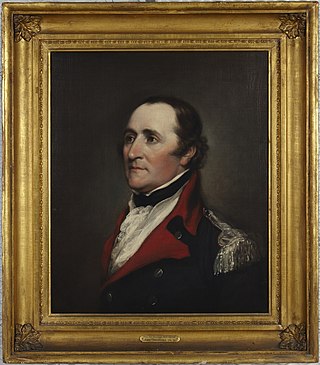Related Research Articles

Ben Hebard Fuller was a major general in the United States Marine Corps and served as the 15th Commandant of the Marine Corps between 1930 and 1934.

Major-General Sir Robert Bellew Adams was a Scottish general of the Indian Army and recipient of the Victoria Cross, the highest and most prestigious award for gallantry in the face of the enemy that can be awarded to British and Commonwealth forces.

Lieutenant-General Sir Percy Henry Noel Lake, served as a senior commander in the British and Indian Armies, and in the Canadian Militia. He served during World War I.

Lieutenant-General William Keppel was a British Army officer and Member of Parliament.

Ebenezer Huntington was an officer in the Continental Army during the American Revolutionary War, and afterwards United States Representative from Connecticut.
General Sir Charles Howard KB, styled The Honourable from birth, was a British soldier and politician.
Lieutenant-General John Keane, 1st Baron Keane of Ghazni, Afghanistan was an Anglo-Irish soldier in the British Army.
Lieutenant General Sir Thomas Arbuthnot, KCB was a British Army commander.

Field Marshal Sir Arthur Arnold Barrett, was a British officer of the Indian Army. He saw action at the Siege of the Sherpur Cantonment in December 1879 and at the Battle of Kandahar in September 1880 during the Second Anglo-Afghan War and went on to serve in the Hunza-Nagar Campaign in 1891. During the First World War he was General Officer Commanding the Poona Division which successfully took Basra in Mesopotamia in November 1914 and then Al-Qurnah in Mesopotamia in December 1914. He spent the rest of the War commanding the Northern Army in which role he took part in operations against the Mahsuds in Spring 1917. He saw action again as the senior British officer on the ground during the Third Anglo-Afghan War in 1919 before retiring in May 1920.
General Sir William Houston, 1st BaronetKC was a British Army officer and Governor of Gibraltar. Houston joined the army in 1781, and by the start of the French Revolutionary War was a captain. He fought in the Flanders campaign before being promoted to major in 1794. As a lieutenant-colonel he fought at the Capture of Minorca and at the sieges of Alexandria and Cairo. Promoted to colonel in 1802, Houston fought in the Walcheren Expedition of 1809 before being promoted to major-general.
Major general Welbore Ellis Doyle (1758–1797) was the third Military Governor of British Ceylon. He was appointed on 1 January 1797 and was Governor until 2 July 1797. He was succeeded by Peter Bonnevaux.
General John Despard (1745–1829) was an Irish-born soldier who had a long and distinguished career in the British Army and as a colonial administrator. He was the brother of Edward Despard, also a soldier, who was executed in 1803 for his part in the Despard Plot.
Major-General John Grey was an officer of the British Army.
Lieutenant-General John Folliot or Folliott was an officer of the British Army.
Major-General Charles Jefferyes was an officer of the British Army.
Lieutenant-General Sir Alfred Robert Martin was a British officer in the Indian Army.

General Sir James Archibald Hope, was a senior officer in the British Army.
General John Longfield, CB was an Irish senior officer in the British Army.
General George Bernard was a British Army officer.
Major-General George Johnstone was a British Army officer. He was commissioned into the infantry 1780, serving in Grenada during Fédon's rebellion in 1795-96. He was afterwards transferred to command a regiment of fencibles in New Brunswick, where he served for a year as acting Lieutenant Governor. In 1810, he was given command of a Highland regiment which served on garrison duty in Cape Colony. Johnstone was promoted to major general in 1814 and given command of the 6th Brigade in the 1815 Waterloo campaign. His brigade was not engaged in the 18 June Battle of Waterloo as they were posted to the extreme right flank, protecting the approaches to Brussels and Ostend. His men fought in the subsequent advance to Paris and helped to storm the fortress of Cambrai on 24 June.
References
- Major H. Everard, History of Thos. Farrington's Regiment, subsequently designated the 29th (Worcestershire) Foot, 1694 to 1891. Worcester, 1891. page 564